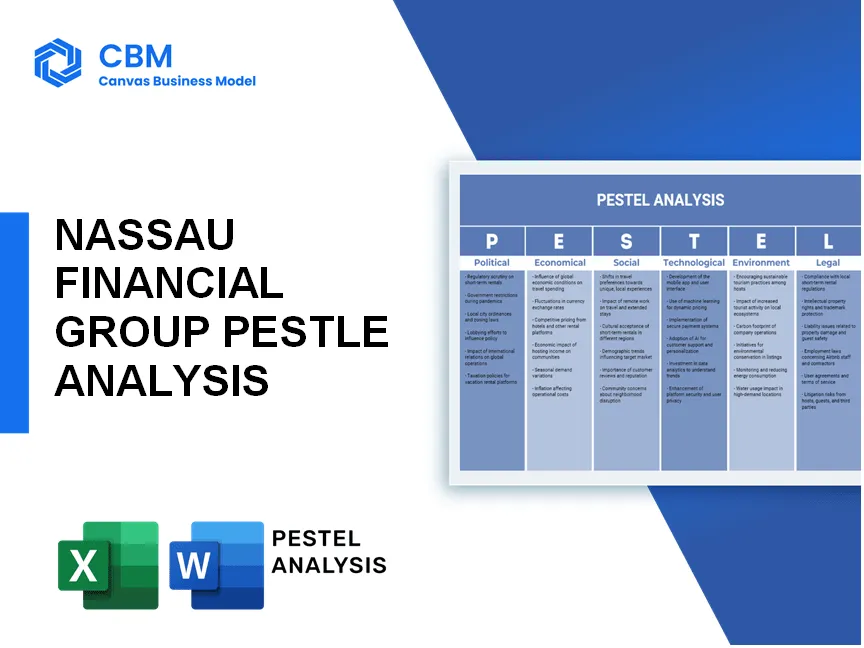In the intricate world of finance, where decision-making is often clouded by uncertainty, understanding the multifaceted influences on companies like Nassau Financial Group becomes essential. Through a comprehensive PESTLE analysis, we explore the vital political, economic, sociological, technological, legal, and environmental factors shaping their operations. This analysis not only reveals how these elements impact their offerings in reinsurance, retirement planning, asset management, life insurance, and annuity products, but also provides crucial insights for stakeholders navigating this complex landscape. Read on to uncover how these dynamics unfold in practice.
PESTLE Analysis: Political factors
Regulatory environment influences reinsurance and insurance markets
The reinsurance and insurance markets are heavily influenced by regulatory frameworks, with the National Association of Insurance Commissioners (NAIC) setting standards. In 2022, the total assets of the U.S. insurance industry reached approximately $8.3 trillion. The regulatory environment includes compliance requirements such as the Risk-Based Capital (RBC) requirement, introduced to ensure that insurance companies maintain adequate capital buffers. The 2021 RBC ratio for life insurers was an average of approximately 400%.
Government policies affect retirement planning frameworks
Government policies such as the Welfare Reform Act of 1996 have a lasting impact on retirement planning frameworks. In 2023, the contribution limit for 401(k) plans is $22,500, with a catch-up contribution of $7,500 for individuals aged 50 and over. The addition of the Secure Act 2.0 introduces provisions to encourage retirement savings, including automatic enrollment.
Taxation laws impact asset management returns
Taxation laws significantly impact returns on investment in the asset management sector. As of 2023, capital gains tax rates can vary, with the federal rate ranging from 0% to 20% depending on income levels. Furthermore, states like California have additional taxes, with a maximum capital gains tax rate of 13.3%. The IRS data for 2022 indicated that U.S. taxpayers paid approximately $207 billion in capital gains taxes.
Lobbying efforts can shape financial regulations
Lobbying plays an essential role in shaping financial regulations. According to the Center for Responsive Politics, the insurance industry spent over $175 million on lobbying efforts in 2021. These efforts influence legislative measures that can affect premium pricing, reserve requirements, and consumer protection laws.
International trade policies may affect investment opportunities
International trade policies directly affect investment prospects for firms like Nassau Financial Group. Trade agreements such as the U.S.-Mexico-Canada Agreement (USMCA) and tariffs affect cross-border investments. As of 2022, U.S. foreign direct investment (FDI) in insurance services reached approximately $18 billion, reflecting the importance of global market access.
| Factor | Current Status | Impact on Nassau Financial Group |
|---|---|---|
| Regulatory environment | NAIC established standards, RBC Ratio ~400% | Requires compliance, affects capital management |
| Retirement planning policies | 401(k) contribution limit: $22,500 | Influences demand for retirement products |
| Taxation laws | Capital gains tax: 0%-20% state taxes | Affects asset management returns |
| Lobbying efforts | Industry spending: $175 million on lobbying | Shapes regulations affecting the insurance market |
| International trade policies | FDI in insurance services: $18 billion | Affects global investment opportunities |
[cbm_pestel_top]
PESTLE Analysis: Economic factors
Global economic conditions affect investment portfolios.
The global economic landscape is constantly evolving, with notable fluctuations affecting various sectors, including financial services. In 2022, global GDP growth was approximately 3.2%, while the International Monetary Fund (IMF) projected a slowdown to 2.9% in 2023 due to factors such as geopolitical tensions and inflationary pressures. Investment portfolios managed by companies like Nassau Financial Group are influenced by these macroeconomic conditions, impacting asset allocation strategies and overall returns.
Interest rates influence annuity pricing and sales.
Interest rates play a critical role in determining the attractiveness of annuity products. In 2023, the U.S. Federal Reserve set the federal funds rate in the range of 4.75% to 5.00%, compared to 0.00% to 0.25% in 2021. This increase has directly influenced annuity sales, with the fixed annuity market experiencing a growth rate of 31% in 2022. Furthermore, the average yield for 10-year U.S. Treasuries increased to approximately 3.7% in early 2023, leading to higher interest rates for new annuity contracts.
Inflation impacts retirement planning effectiveness.
Inflation significantly affects the purchasing power of retirees. In 2022, the Consumer Price Index (CPI) rose by 7.0%, the highest annual increase in nearly four decades. As of 2023, the inflation rate has moderated to approximately 4.4%, yet it remains a concern for long-term retirement planning. The average monthly Social Security benefit for retirees in January 2023 was around $1,827, which needs to be adjusted for inflation to maintain purchasing power.
Economic downturns can lead to increased claims.
During economic downturns, claims across various insurance products may increase due to higher unemployment rates and financial stress. For instance, during the COVID-19 pandemic, life insurance claims surged by 15% to 20% in 2020, according to industry reports. The National Association of Insurance Commissioners (NAIC) reported a substantial increase in disability claims as employment levels dropped. In 2023, the unemployment rate was reported at 3.6%, indicating economic stability, yet potential risks remain during recessions.
Employment rates determine demand for life insurance products.
Employment rates are directly correlated with the demand for life insurance products. As of July 2023, the U.S. unemployment rate was recorded at 3.5%, suggesting a strong labor market. According to LIMRA Insurance Research, approximately 60% of consumers who are employed are more likely to purchase life insurance. Conversely, during a downturn, potential buyers may delay these purchases due to financial constraints.
| Economic Indicator | 2022 Value | 2023 Value |
|---|---|---|
| Global GDP Growth | 3.2% | 2.9% |
| Federal Funds Rate | 0.00% to 0.25% | 4.75% to 5.00% |
| Average Yield for 10-Year Treasuries | N/A | 3.7% |
| Consumer Price Index Increase | 7.0% | 4.4% |
| Average Monthly Social Security Benefit | $1,827 | N/A |
| Life Insurance Claims Increase (COVID-19) | 15% to 20% | N/A |
| Unemployment Rate | N/A | 3.6% |
| Likelihood of Life Insurance Purchase (Employed) | N/A | 60% |
PESTLE Analysis: Social factors
Aging population increases demand for retirement products.
The population aged 65 and older is projected to reach 88 million by 2050, up from 56 million in 2020, indicating an annual growth rate of roughly 3.2%.
According to the U.S. Census Bureau, individuals aged 65 and older represented 16.5% of the U.S. population in 2020, and that figure is expected to increase to 23.0% by 2060.
Changes in family structures influence life insurance needs.
As of 2021, about 14% of families in the U.S. were single-parent households, highlighting a shift in traditional family structures.
According to LIMRA, approximately 30% of parents with children under age 18 do not own any life insurance, which indicates a potential market for Nassau Financial Group's life insurance products.
Consumer attitudes toward savings impact financial planning.
A report by Bankrate in 2021 found that only 32% of Americans had enough savings to cover a $1,000 emergency expense, illustrating a significant gap in financial preparedness.
Furthermore, 62% of Americans stated they are worried about their current financial situation, according to a survey conducted by Gallup in 2022.
Health awareness affects annuity market growth.
The global annuity market was valued at approximately $2.68 trillion in 2020 and is anticipated to grow at a CAGR (compound annual growth rate) of around 5.5% from 2021 to 2028.
According to the National Council on Aging, more than 80% of older adults have at least one chronic health condition, affecting their financial planning for retirement.
Cultural factors shape insurance purchasing behavior.
A 2021 study by Insurance Information Institute reported that 35% of Americans believe life insurance is essential, while 48% believe it is a luxury, highlighting varying perceptions influenced by cultural factors.
Research from the National Association of Insurance Commissioners indicates that cultural factors can significantly affect purchasing decisions, with 44% of respondents stating they prefer buying insurance from agents who share their cultural background.
| Social Factor | Current Data | Projections/Impacts |
|---|---|---|
| Aging Population | 56 million aged 65 (2020) | 88 million aged 65 by 2050 |
| Changes in Family Structures | 14% of U.S. families are single-parent households (2021) | 30% of parents with children under 18 lack life insurance |
| Consumer Attitudes | 32% have $1,000 emergency savings (2021) | 62% worry about financial situation |
| Health Awareness | $2.68 trillion global annuity market (2020) | 5.5% CAGR from 2021 to 2028 |
| Cultural Factors | 35% believe insurance is essential | 44% prefer agents of similar cultural backgrounds |
PESTLE Analysis: Technological factors
Advancements in fintech enhance service delivery
The integration of fintech innovations has significantly transformed service delivery in the financial services sector. According to a 2021 report by McKinsey, global investment in fintech reached around $138 billion in venture capital funding, highlighting the rapid growth and adoption of technology in finance. Nassau Financial Group can leverage such advancements to streamline their product offerings and improve customer interactions, enabling them to remain competitive in a dynamic market.
Data analytics improve risk assessment processes
Data analytics plays a critical role in enhancing risk assessment methodologies. The global data analytics in insurance market is projected to reach $10.78 billion by 2025, growing at a CAGR of 20.4% from 2020. By utilizing predictive analytics, Nassau can better assess risks and make informed underwriting decisions, which can result in a 15%-20% improvement in accuracy compared to traditional methods.
Online platforms streamline distribution channels
Online distribution platforms have revolutionized how financial products are marketed and sold. As of 2020, the digital life insurance market was valued at approximately $6.16 billion and is projected to grow at a CAGR of 6.29% from 2021 to 2028. This shift enables Nassau Financial Group to reach a wider audience and reduce distribution costs by an estimated 25%, thereby increasing overall profitability.
| Service Area | Current Market Size | CAGR 2021-2028 |
|---|---|---|
| Digital Life Insurance | $6.16 billion | 6.29% |
| Data Analytics in Insurance | $10.78 billion | 20.4% |
| Fintech Investment | $138 billion | N/A |
Cybersecurity measures safeguard sensitive information
The increase in digital transactions has heightened the importance of cybersecurity. In 2021, global spending on cybersecurity reached $150 billion, with projections estimating up to $345.4 billion by 2026. Implementing robust cybersecurity frameworks can reduce the potential financial impact of data breaches by an estimated 30%, which is crucial for companies like Nassau Financial Group handling sensitive customer data.
Automation improves operational efficiency in asset management
Automation technologies have become integral to enhancing operational efficiency in asset management. A survey conducted by Deloitte in 2020 revealed that 40% of financial services organizations plan to increase their use of automation in the next two years. By employing automated solutions, Nassau can reduce operational costs by an estimated 20%-30% while improving service delivery speed, thereby optimizing client satisfaction.
PESTLE Analysis: Legal factors
Compliance with financial regulations is mandatory.
The insurance and financial services industry is heavily regulated in the United States and globally. Nassau Financial Group must comply with regulations set forth by various entities such as the National Association of Insurance Commissioners (NAIC), which has developed a comprehensive framework for market conduct and solvency regulation. In 2021, insurers had to comply with new regulations amounting to approximately $350 billion in compliance costs associated with federal and state laws.
Consumer protection laws affect product offerings.
Consumer protection laws such as the Fair Credit Reporting Act (FCRA) and the Gramm-Leach-Bliley Act (GLBA) are critical in shaping Nassau Financial Group’s product offerings. Compliance with these laws ensures transparency and fairness in the treatment of customers. In 2022, U.S. insurance regulators reported over 20,000 consumer complaints related to unfair practices, which necessitated stringent adherence to consumer protection guidelines.
Privacy laws govern data handling and storage.
The General Data Protection Regulation (GDPR) in Europe and the California Consumer Privacy Act (CCPA) in the U.S. impose heavy penalties for non-compliance in data handling. For instance, violation of GDPR can result in fines up to €20 million or 4% of global turnover, whichever is higher. It is estimated that companies faced Privacy-related litigation costs that reached $1.5 billion in 2023.
Legal interpretations of contracts influence claims processing.
Legal frameworks play a pivotal role in the interpretation of insurance contracts. Various court cases have resulted in precedents that directly affect claims processing. For instance, according to the Insurance Information Institute, in 2022, approximately $16 billion in claims were contested due to discrepancies in contract interpretations. Additionally, around 30% of insurance disputes in courts were related to ambiguous contractual terms.
Intellectual property rights protect proprietary technologies.
Nassau Financial Group needs to safeguard its proprietary technology and systems through patents and trademarks. The financial services industry made significant investments in intellectual property, with the total value of financial services patents reaching $40 billion in 2022. In 2023, the U.S. Patent and Trademark Office reported over 3000 new patents filed in financial technologies, emphasizing the importance of intellectual property in maintaining competitive advantage.
| Legal Factor | Details | Financial Impact |
|---|---|---|
| Compliance with financial regulations | NAIC regulatory framework | $350 billion in compliance costs (2021) |
| Consumer protection laws | FCRA, GLBA | 20,000 consumer complaints (2022) |
| Privacy laws | GDPR, CCPA | Fines up to €20 million; $1.5 billion in litigation (2023) |
| Legal interpretations of contracts | Insurance contract disputes | $16 billion in contested claims (2022); 30% of disputes |
| Intellectual property rights | Patent protections | $40 billion IP value; 3000 patents filed (2023) |
PESTLE Analysis: Environmental factors
Climate change affects risk calculations in reinsurance.
The reinsurance sector is adapting to the increasing frequency of natural disasters attributed to climate change. In 2021, the global cost of natural disasters exceeded $329 billion, with insured losses accounting for approximately $130 billion.
The **International Association of Insurance Supervisors (IAIS)** has noted that climate change could increase insurance risk by **25%** by 2050, creating significant implications for firms like Nassau Financial Group.
Sustainability trends influence investment strategies.
As of 2023, the global sustainable investment market reached **$35.3 trillion**, growing by **15%** over the previous year. Financial institutions are increasingly integrating ESG (Environmental, Social, and Governance) factors into their portfolio management strategies.
Nassau's investment in sustainable assets reflects a broader trend, as **78%** of institutional investors cited sustainability as a priority in their investment objectives. This shift also aligns with a **$60 trillion** estimated transfer of wealth to millennials, who prioritize sustainable and responsible investment opportunities.
Regulatory pressures drive green insurance products.
Regulatory frameworks are tightening globally, with **more than 500** climate-related policies implemented since 2020. For example, the European Union's Sustainable Finance Disclosure Regulation (SFDR) requires financial institutions to disclose how sustainability risks are integrated into their processes.
As a consequence of these regulatory pressures, the market for green insurance products is projected to grow at a CAGR of **13%**, reaching **$4.8 billion** by 2025. Companies are increasingly developing products that mitigate environmental risks while adhering to regulatory expectations.
Environmental disasters impact actuarial assumptions.
Actuarial assumptions are being reevaluated due to the influence of environmental disasters on loss projections. The **National Oceanic and Atmospheric Administration (NOAA)** reported that from 1980 to 2021, the U.S. experienced **322 weather and climate disasters**, each resulting in damages exceeding **$1 billion**, emphasizing the need for refined actuarial modeling.
Inclusion of climate risk into models now accounts for an estimated **$40 billion** in additional reserves required by reinsurers annually to cover potential losses from natural events.
Public sentiment promotes responsible corporate governance.
Public sentiment is increasingly favoring companies that prioritize environmental responsibility. A 2022 study found that **86%** of consumers are more likely to support businesses that practice sustainability. Furthermore, **71%** of institutional investors consider corporate governance practices when making investment decisions.
Moreover, companies publicly committing to sustainability initiatives have witnessed improved brand loyalty and engagement, with a reported **19%** increase in customer retention as a direct outcome of enhanced corporate governance aligning with environmental responsibility.
| Metric | 2021 | 2022 | 2023 |
|---|---|---|---|
| Global Natural Disaster Costs (in billions) | 329 | 240 (Q3) | Unknown |
| Insured Losses (in billions) | 130 | 74.1 | Unknown |
| Global Sustainable Investment Market (in trillions) | 30.7 | 35.3 | 35.3 |
| Projected Market for Green Insurance Products (in billions) | 3.4 | 4.3 | 4.8 (2025) |
| Climate-Related Policies Implemented | 300 | 500 | Unknown |
| U.S. Weather and Climate Disasters (1980-2021) | 322 | Unknown | Unknown |
| Estimated Reserves Required by Reinsurers (in billions) | 25 | 30 | 40 |
| Consumer Likelihood to Support Sustainable Companies (%) | 78 | 86 | Unknown |
| Increase in Customer Retention from Sustainability (%) | 15 | 19 | Unknown |
In summary, the PESTLE analysis for Nassau Financial Group reveals a complex landscape filled with both challenges and opportunities. Understanding the **political** climate, **economic** fluctuations, **sociological** trends, **technological** innovations, **legal** frameworks, and **environmental** concerns is critical for navigating the financial services sector effectively. By leveraging these insights, Nassau Financial Group can enhance its strategic planning and deliver valuable solutions that meet the evolving needs of its clients.
[cbm_pestel_bottom]












